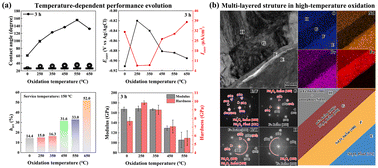Achieving high magnetic properties and corrosion resistance simultaneously is a common goal for Nd–Fe–B permanent magnetic materials but remains challenging via traditional strategies. Herein, we conducted wide-range oxidation experiments to construct a tunable surface oxidation layer. Temperature-dependent and time-dependent oxidation behaviors of the typical N50 commercial-grade Nd–Fe–B sintered magnets with corresponding performance evolutions were systematically unraveled. Results showed that short-term low-temperature oxidation at 350 °C for 0.5 h or 250 °C for 3 h generated an excellent synergy of improved corrosion resistance and mechanical performance without compromising magnetic properties owing to the formation of a thin hydrophobic oxidation layer with fewer microscopic cracks under low kinetic coefficients (1.1 × 10−17 to 9.5 × 10−16 m2 s−1). High oxidation temperatures of 450–650 °C with exponentially increased kinetic coefficients (1.5 × 10−14 to 3.2 × 10−12 m2 s−1) lowered the anti-corrosion, mechanical and magnetic performance owing to the thickening of the oxidation layer with macroscopic cracks despite having superhydrophobic characteristics. With respect to the high-temperature oxidation mechanism, the formation of continuous and coarse grain boundary (GB) networks with multi-layered structures was identified in the internal oxidation zone for the first time. The multi-layered structure could be divided into four layers, with the first and second layers comprising continuous Nd/Pr/O-rich GBs with maximum oxygen concentration (P![[3 with combining macron]](https://www.rsc.org/images/entities/char_0033_0304.gif) m1 and Im
m1 and Im![[3 with combining macron]](https://www.rsc.org/images/entities/char_0033_0304.gif) m/Ia
m/Ia![[3 with combining macron]](https://www.rsc.org/images/entities/char_0033_0304.gif) structured Nd2O3), the third layer comprising the Fe-rich intermediate layer with extremely low concentrations of Nd/Pr and O (dominated by Im
structured Nd2O3), the third layer comprising the Fe-rich intermediate layer with extremely low concentrations of Nd/Pr and O (dominated by Im![[3 with combining macron]](https://www.rsc.org/images/entities/char_0033_0304.gif) m structured α-Fe), and the fourth layer comprising a mixture of Fe, Nd/Pr and O (coexisting Im
m structured α-Fe), and the fourth layer comprising a mixture of Fe, Nd/Pr and O (coexisting Im![[3 with combining macron]](https://www.rsc.org/images/entities/char_0033_0304.gif) m structured α-Fe and amorphous Nd2O3). In the external oxidation zone, the single crystalline α-Fe phase without amorphous Nd2O3 was observed. Both features accelerated the inward oxygen diffusion and explained the high oxidation kinetics of the 650 °C oxidized magnet. The above correlation between the tunable oxidation behaviors and performance of the oxidized Nd–Fe–B magnets along with the temperature-dependent oxidation mechanisms provide new understandings for delicately controlling the corrosion-resistant oxidation coatings.
m structured α-Fe and amorphous Nd2O3). In the external oxidation zone, the single crystalline α-Fe phase without amorphous Nd2O3 was observed. Both features accelerated the inward oxygen diffusion and explained the high oxidation kinetics of the 650 °C oxidized magnet. The above correlation between the tunable oxidation behaviors and performance of the oxidized Nd–Fe–B magnets along with the temperature-dependent oxidation mechanisms provide new understandings for delicately controlling the corrosion-resistant oxidation coatings.
